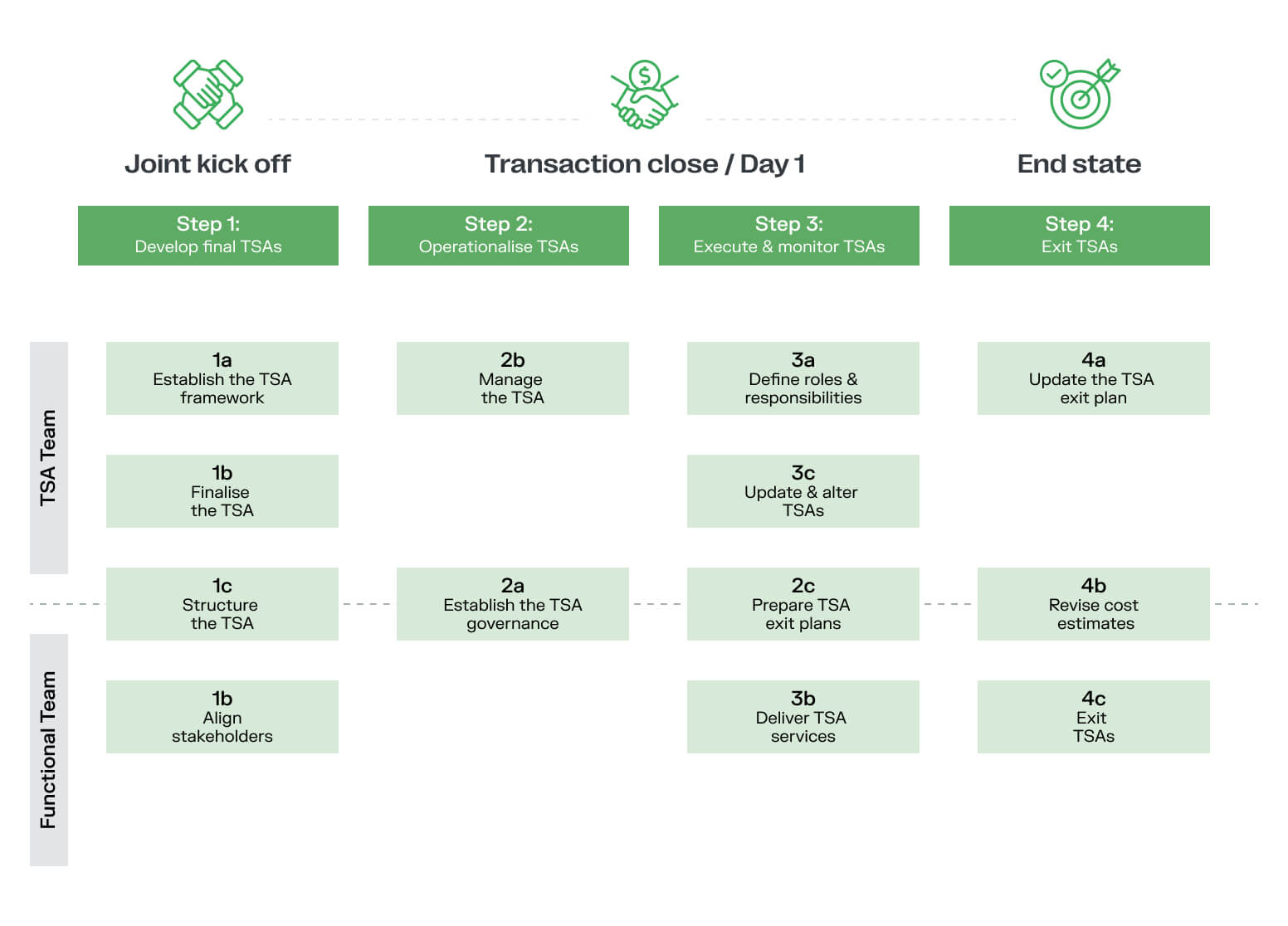Understanding transition service agreements: Benefits & best practices

Blackrock’s 2024 Private Markets Outlook predicts increased carve-out activity, where companies are expected to sell off non-core or struggling business divisions. This trend is driven by both sellers aiming to streamline their operations and buyers seeking to capitalize on potential value in these carve-out assets.
Companies planning to engage in carve-out transactions should consider the importance of a transition services agreement — a crucial part of the merger and acquisition process that ensures a smooth transition of operations from the seller to the buyer, minimizing disruptions and facilitating integration.
This article highlights the key considerations surrounding transition service agreements, exploring their significance, components, and best practices for effective implementation.
What is a transition service agreement?
A transition service agreement (TSA) is a contract between the buyer and the seller in a merger or acquisition deal. It’s most commonly employed in a carve-out transaction when certain assets or divisions are being divested. It outlines the terms and conditions under which the seller agrees to provide certain services, support, or resources to the buyer for a set period after the acquisition.
In short, transition service agreements are used to facilitate the transfer of operations from the seller to the buyer, allowing for a smoother transition.
There are forward and reverse transition service agreements:
- In a forward TSA, the seller agrees to provide services to the buyer after the transaction closes. This is the most common type of TSA and is used when the buyer needs support during the transition period to integrate the acquired business into its operations.
- In a reverse TSA, the buyer agrees to provide services to the seller after the transaction closes. This arrangement is less common but may occur when the seller needs temporary support from the buyer to continue operating certain functions or services post-transaction.
You may have a look at the TSA agreement between Expedia and TripAdvisor to understand how such agreements are structured and implemented in real-world scenarios. You may also use it as a transition service agreement template.
As a rule, key elements of a transition services agreement include:
1. Scope of TSA services
This section defines the specific services or resources that the seller will provide to the buyer. These may include IT support, human resources, accounting, customer service, or other operational functions.
2. TSA period
TSA process timeline is specified, detailing the start and end dates of the transition period. This period can range from a few months to a year or more, depending on the complexity of the transition.
3. Service level agreements (SLAs)
SLAs outline the performance standards and expectations for the services provided under the TSA, including metrics such as response times, uptime, and service quality.
4. Cost and payment terms
The financial terms of the agreement, including any fees or payments to be made by the buyer to the seller for the services rendered. This may include upfront payments, ongoing fees, or reimbursement of expenses.
5. Termination provisions
Conditions under which two parties can terminate the transitional service agreement before the expiration date, including provisions for early termination penalties or exit procedures.
How to manage a TSA
Now let’s explore the key steps regarding TSA development, implementation, and termination:
| TSA process stages | Buyer (service receiver) activities | Seller (service provider) activities |
| 1. Identification | Identifies the required services and the timeframe. | Provides information about sold division operations. |
| 2. Negotiation | Discusses exit strategy and future service handling (in-house, terminate, outsource). | Identifies service pricing and clarifies financial responsibility. |
| 3. Drafting and signing | Collaborative drafting, editing, and signing of the transitional services agreement. Make sure the entire agreement and its terms are clear for both parties involved. | Same as for a buyer |
| 4. Monitoring | Buyer’s TSA manager monitors service performance and communicates issues. | Seller’s TSA manager ensures proper service delivery, billing, and timely issue resolution. |
| 5. Fees collection | Pays for services promptly and accurately as per agreement terms. | Regularly sends invoices to ensure timely and accurate payment for services. |
| 6. Termination | Issues termination notice within the defined period when services are no longer required. | Accepts termination, communicates fees, and completes knowledge transfer for a smooth transition. |
Note: It’s in the buyer and seller’s best interests to accelerate the TSA exit and separate their operations quickly. This way, they can focus fully on their own businesses without any distractions or delays.
Key benefits of a TSA
Here are the main advantages of a transition services agreement M&A:
1. Smooth transition
TSAs help facilitate the transition of operations from the seller to the buyer, ensuring continuity and minimizing disruption to business operations.
2. Flexibility
TSAs provide flexibility for the buyer to gradually integrate the acquired business into their own operations at a pace that suits their needs.
3. Minimized risk
By allowing the buyer to rely on the seller’s expertise and infrastructure for a specified period, TSAs help mitigate the risks associated with transitioning to a new business environment.
4. Maintained service levels
TSAs ensure that essential services continue to be provided at pre-agreed levels of quality and performance during the transition period, maintaining customer satisfaction and business continuity.
5. Reduced transition costs
TSAs can help reduce transition costs by avoiding the need for immediate investment in new infrastructure, systems, or personnel.
6. Focus on core business
By outsourcing certain functions to the seller during the transition period, the buyer can focus on their core business activities without being overwhelmed by integration challenges.
7. Better transaction price
A well-prepared TSA can attract potential buyers to the seller’s business or asset, leading to a higher transaction price. This is because buyers are more inclined to engage with assets that offer a smoother transition and access to the seller’s resources through a TSA.
8. Clean separation
TSAs enable buyers to limit liabilities and risks inherited from the purchased business, while also protecting the seller’s reputation. TSAs contribute to a well-organized separation process by outlining responsibilities and obligations.
Challenges related to transitional services agreements
Drafting a transition services agreement form can be challenging for both the buyer and seller. Here’s why:
- Terms and conditions
Negotiating the terms of services can be challenging due to different goals and expectations between the seller and buyer. Buyers often require flexible TSA terms, including options for extension, while sellers may seek clarity on the end date of service provision. Balancing these requirements while ensuring a fair and mutually beneficial agreement can be complex.
- Price
Service providers must accurately price their services to ensure fair compensation without underpricing. Buyers, on the other hand, require transparency and clarity in costing to avoid overpaying and to budget effectively for the transition.
- Performance levels
Unlike traditional commercial contracts, TSAs may not always include detailed service-level agreements. Negotiating precise service levels can be complex and time-consuming, as service providers may be less motivated to adhere to performance requirements in short-term agreements.
There are challenges unique to a service receiver:
- Seller’s motivation
Sellers’ lack of motivation to support the transition can slow down the acquisition process, potentially leading to disruptions in obtaining essential post-closing services. Nearly half of surveyed buyers report not receiving transition services post-acquisition.
- Incorrect assessment of services
Sellers may inaccurately assess the services needed for the transition, leading to delays, excessive costs, and a failure to realize the expected value from the agreement.
Challenges unique to the other party include:
- Disruption of operations
Poorly planned TSAs can disrupt the operations of the seller’s team, leading to decreased productivity and potential loss of customers. Key employees may become disproportionately involved in delivering transition services, diverting their focus from running the seller’s business effectively.
- Reputational damage
The sold part of the business remains associated with the seller’s company, even though it’s no longer fully under their control. As a result, the seller faces risks such as data breaches, service quality degradation, compliance issues, and unexpected liabilities during the transition. This can damage the seller’s reputation.
Best practices for developing an effective TSA
Let’s refer to the transition service agreement checklist the Deloitte team offers and explore the best practices they provide for developing an effective TSA.

1. Define services early
Initiate discussions regarding transition services before a buyer is identified to streamline negotiations and ensure clarity on service scope and costs. Utilize functional blueprints to map out the scope of services and processes to be covered under the TSA. Upon identifying a buyer, refine the scope of services during initial negotiations to align with the buyer’s needs and preferences.
2. Establish the right team
Create a cross-functional team comprising key stakeholders from both the seller and buyer organizations to oversee TSA planning and execution. Clearly define roles and responsibilities to ensure accountability and effective collaboration. Develop a robust escalation path to address any issues promptly and minimize disruptions during the transition period.
3. Focus on speed
Set clear performance metrics and service level targets to measure the delivery of transition services. Prioritize speed and efficiency over achieving overly ambitious performance levels to speed up the transition process. Include specific penalties in the TSA for instances where the seller fails to meet agreed-upon service levels, incentivizing timely completion.
4. Prepare for the post-TSA phase
Agree on a comprehensive exit approach and transition timeline for each service in the TSA schedule. Determine whether to build, outsource, or terminate functions post-TSA and develop an exit plan considering interdependencies and stakeholder inputs. Maintain realistic expectations regarding the TSA end date to facilitate effective planning and transition readiness.
5. Address data privacy and IP concerns
When developing the TSA, ensure that data protection and intellectual property (IP) concerns are addressed. Interactions between the seller and divested firm post-closing are similar to outsourcing agreements and must comply with data protection regulations. Clearly outline data sharing protocols in the TSA to comply with privacy requirements and protect Personally Identifiable Information (PII) to minimize legal risks.
FAQ
TSA means a transition service agreement. It’s a legal document commonly used in mergers and acquisitions to facilitate the transition of operations from the seller to the buyer. It outlines the terms under which the selling company agrees to provide certain services to the purchasing company for a specified period after the completion of a transaction.
No third-party service providers are participating in the agreement.
Transition service agreement consulting involves seeking expert guidance and support from consultants who specialize in managing the complexities of TSAs. These consultants offer strategic advice, assist in drafting agreements, and provide insights into best practices for successful implementation.
The duration of the TSA process can vary depending on various factors such as the complexity of the merger or acquisition, the scope of services covered under the agreement, and the level of collaboration between the buyer and seller. Generally, the TSA process may take several weeks to a year. Six months is the most common duration.